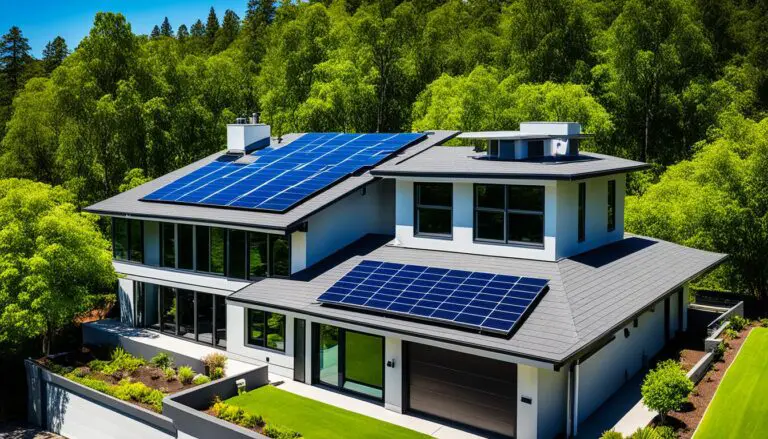Hello! Welcome to our detailed guide on solar panel tech. In this piece, we will explore the world of solar energy. We’ll explain how it works and its rising popularity as a green energy choice. So, let’s dive in and illuminate the subject of solar panels!
Key Takeaways
- Solar power is a clean and renewable energy source.
- Solar panels use the photovoltaic effect to convert sunlight into electricity.
- Solar power systems can be grid-tied, solar-plus-storage, or off-grid.
- The cost of solar power systems has significantly dropped in recent years.
- Solar power reduces carbon emissions and is supported by governments worldwide.
How Solar Panels Work
Solar panels harness the sun’s power for clean, renewable energy. They’re key to using solar power effectively. Let’s dive into how solar panel technology works.
Solar panels have cells mostly made of silicon. When sunlight hits these cells, they generate electricity through a process called the photovoltaic effect.
This effect gets electrons in silicon moving, producing an electric current. This electricity starts as direct current (DC). Then, using solar inverters, it’s converted to alternating current (AC), the type of power in our homes and businesses.
Solar power is green and doesn’t harm the environment. Using solar panels helps fight climate change by lowering our carbon emissions.
Different solar power setups exist for homes. The grid-tied system connects to the utility grid. It lets you use the grid when you need more electricity.
Another option is solar-plus-storage systems. They store extra energy in batteries for use when it’s cloudy or at night.
Then there’s the off-grid system, which only relies on solar power. It’s perfect for remote places without easy access to the grid.
To wrap up, solar panels convert sunlight into electricity through the photovoltaic effect. With inverters, this electricity powers our buildings. This way, we use less fossil fuels and support sustainable energy.
Going Solar: Considerations and Benefits
There are two ways to use solar energy: rooftop solar or community solar projects. Rooftop solar means putting panels on your roof. But, your roof must get good sunlight and have the right layout.
Community solar is a different choice when rooftop panels don’t work for you. In community solar, a group of people share a large solar setup. This way, you get solar energy benefits without having panels at home.
Checking if your roof fits solar panels is key. Use online tools to see if your roof gets enough sun. Also, talking to solar experts can give you a clear plan and price.
After setting up your solar system, use monitoring tools to keep it running well. These tools track how well your panels work. They help make sure your system saves you money on energy bills.
There are many ways to pay for your solar system. You can buy it, get a loan, lease it, or choose a power purchase option. These choices help make solar energy easy to get into your budget.
To help you start with solar, lots of tools and information are out there. Websites like PVWatts and DSIRE guide you on how to set up solar, find incentives, and follow local rules. Using these can help you move confidently into using solar energy.


